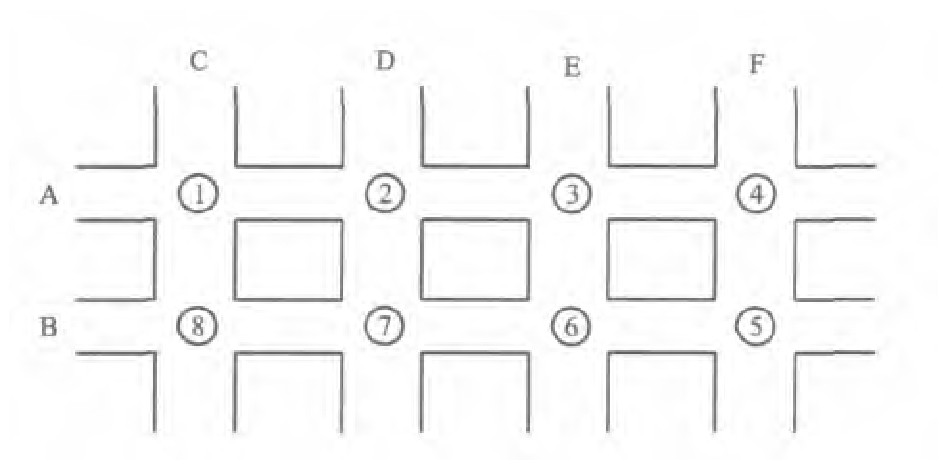Coordinated control model of regional traffic signals
-
摘要: 为提高交通区域通行效率, 构建了适合各种交通状态的区域信号协调控制模型。以区域交叉口总排队车辆数与区域总输出车辆数为性能指标, 考虑上下周期排队车辆数、各交叉口闭合相位差与有效绿灯时间, 建立了模型约束条件。利用粒子群算法初始化有效绿灯时间与滞留车辆数, 采用模拟退火算法求解有效绿灯时间, 在不同交通状态下对某交叉口路网进行了仿真。仿真结果表明: 与TRANSYT模型相比, 低峰时段, 采用本文模型排队车辆数降低了5.3%, 区域总输出车辆数增加了5.5%;高峰时段, 排队车辆数降低了17.9%, 区域总输出车辆数增加了33.4%。交叉口的信号方案优化结果表明: 与TRANSYT模型相比, 采用本文模型时, 各车道饱和度均降低, 平均为1.8%, 最大排队车辆数平均降低2.9%。分析结果表明: 本文模型在各种交通状态下都是有效的, 特别是在高峰状态下, 控制效果优于TRANSYT模型。Abstract: In order to improve the traffic efficiency of traffic area, a coordinated control model of regional signals was constructed under all kinds of traffic conditions.The total queue vehicle number and the total output vehicle number of regional intersection were used as performance indexes of the model.The constraint conditions of the model were established by considering the variable relationship of the adjacent cycle queue vehicle numbers, closed phase difference of intersections and effective green time.The effective green time and waiting vehicle number were initialized by particle swarm algorithm.The effective green time was solved by simulated annealing algorithm.The road network of a certain intersection was simulated under different traffic states.Simulation result shows that the queue vehicle number reduces by 5.3% and the total output vehicle number of region increases by 5.5% in low peak period compared with the TRANSYT model.The queue vehicle number reduces by 17.9% and the total output vehicle number of region increases by 33.4% in peak period compared with the TRANSYT model.The signal optimizing scheme of a regional intersection shows that the lane saturations averagely reduce by 1.8% and the queue vehicle number averagely decrease by 2.9% comparing with the TRANSYT model.It's proved that the model is effective in all kinds of traffic conditions, especially in peak period, its control effect is better than the TRANSYT model.
-
表 1 路网物理属性
Table 1. Physical attributes of road network

表 2 仿真结果对比
Table 2. Comparison of simulation results
veh 
表 3 性能指标对比
Table 3. Comparison of performance indexes

-
[1] ABOUDOLAS K, PAPAGEORGIOU M, KOUVELAS A, et al. A rolling-horizon quadratic-programming approach to the signal control problem in large-scale congested urban road networks[J]. Transportation Research Part C: Emerging Technologies, 2010, 18(5): 680-694. doi: 10.1016/j.trc.2009.06.003 [2] ABOUDOLAS K, PAPAGEORGIOU M, KOSMATOPOU-LOS E. Store-and-forward based methods for the signal control problem in large-scale congested urban road networks[J]. Transportation Research Part C: Emerging Technologies, 2009, 17(2): 163-174. doi: 10.1016/j.trc.2008.10.002 [3] GIRIANNA M, BENEKOHAL R F. Using genetic algorithms to design signal coordination for oversaturated networks[J]. Intelligent Transportation System, 2004, 8(2): 117-129. doi: 10.1080/15472450490435340 [4] 李水友, 刘智勇. 基于D-S证据理论的区域交通自适应协调控制[J]. 控制理论与应用, 2005, 22(1): 157-160. doi: 10.3969/j.issn.1000-8152.2005.01.032LI Shui-you, LIU Zhi-yong. D-S evidence theory based adap-tive control method for urban traffic network signal[J]. Control Theory and Applications, 2005, 22(1): 157-160. (in Chinese). doi: 10.3969/j.issn.1000-8152.2005.01.032 [5] 张辉, 杨玉珍, 李振龙, 等. 基于分布式Q学习的区域交通协调控制的研究[J]. 武汉理工大学学报: 交通科学与工程版, 2007, 31(6): 1121-1124. doi: 10.3963/j.issn.2095-3844.2007.06.047ZHANG Hui, YANG Yu-zhen, LI Zhen-long, et al. Urban traffic coordination control based on distributed Q-learning[J]. Journal of Wuhan University of Technology: Transportation Science and Engineering, 2007, 31(6): 1121-1124. (in Chinese). doi: 10.3963/j.issn.2095-3844.2007.06.047 [6] 雷磊, 吴洋, 刘昱岗. 过饱和交叉口群系统建模及优化模型[J]. 计算机工程与应用, 2010, 46(4): 26-28. doi: 10.3778/j.issn.1002-8331.2010.04.008LEI Lei, WU Yang, LIU Yu-gang. System modeling and optimization model of oversaturated intersection group[J]. Computer Engineering and Applications, 2010, 46(4): 26-28. (in Chinese). doi: 10.3778/j.issn.1002-8331.2010.04.008 [7] 李岩, 过秀成, 杨洁, 等. 过饱和状态交叉口群信号控制机理及实施框架[J]. 交通运输系统工程与信息, 2011, 11(4): 28-34. doi: 10.3969/j.issn.1009-6744.2011.04.005LI Yan, GUO Xiu-cheng, YANG Jie, et al. Mechanism analy-sis and implementation framework for traffic signal control of over-saturated intersection group[J]. Journal of Transporta-tion Systems Engineering and Information Technology, 2011, 11(4): 28-34. (in Chinese). doi: 10.3969/j.issn.1009-6744.2011.04.005 [8] 刘智勇, 李水友. 基于免疫遗传算法的区域交通自适应协调控制[J]. 控制理论与应用, 2006, 23(1): 119-125. https://www.cnki.com.cn/Article/CJFDTOTAL-KZLY200601024.htmLIU Zhi-yong, LI Shui-you. Immunity genetic algorithms based adaptive control method for urban traffic network signal[J]. Control Theory and Applications, 2006, 23(1): 119-125. (in Chinese). https://www.cnki.com.cn/Article/CJFDTOTAL-KZLY200601024.htm [9] 徐建闽, 首艳芳, 卢凯. 基于双层规划模型的交通信号区域协调控制[J]. 华南理工大学学报: 自然科学版, 2011, 39(3): 95-100, 106. https://www.cnki.com.cn/Article/CJFDTOTAL-HNLG201103021.htmXU Jian-min, SHOU Yan-fang, LU Kai. Area coordinated control of traffic signals based on bi-level programming model[J]. Journal of South China University of Technology: Natural Science Edition, 2011, 39(3): 95-100, 106. (in Chinese). https://www.cnki.com.cn/Article/CJFDTOTAL-HNLG201103021.htm [10] EBERHART R C, SHI Y H. Particle swarm optimization: developments, applications and resources[C]∥IEEE. Proceedings of the 2001Congress on Evolutionary Computation. Seoul: IEEE, 2001: 81-86. [11] 张兰, 雷秀娟, 马千知. 基于粒子群优化算法的多交叉口信号配时[J]. 计算机应用研究, 2010, 27(4): 1252-1254, 1292. https://www.cnki.com.cn/Article/CJFDTOTAL-JSYJ201004012.htmZHANG Lan, LEI Xiu-juan, MA Qian-zhi. Multi-cross signal timing based on particle swarm optimization algorithm[J]. Application Research of Computers, 2010, 27(4): 1252-1254, 1292. (in Chinese). https://www.cnki.com.cn/Article/CJFDTOTAL-JSYJ201004012.htm -





 下载:
下载:





